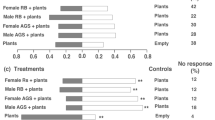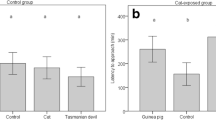Abstract
Predator odors often repel prey species. In the present experiments, we investigated whether changes in the diet of a predator, the coyote (Canis latrans) would affect the repellency of its urine. Furthermore, because predator odors have a high sulfur content, reflecting large amounts of meat in the diet, we investigated the contribution of sulfurous odors to repellency. Our results were consistent with the hypothesis that diet composition and sulfurous metabolites of meat digestion are important for the repellency of predator odors to potential prey.
Similar content being viewed by others

References
Abbott, D.H., Baines, D.A., Faulkes, C.G., Jennens, D.C., Ning, P.C.Y.K., andTomlinson, A.J. 1990. A natural deer repellent: chemistry and behavior, pp. 599–609,in D.W. Macdonald, D. Muller-Schwarze, and S.E. Natynczuk (eds.). Chemical Signals in Vertebrates 5. Oxford University Press, Oxford.
Bullard, R.W., Turkowski, F.J., andKilburn, S.R. 1983. Responses of free-ranging coyotes to lures and their modifications.J. Chem. Ecol. 9:877–888.
Dickman, C.R., andDoncaster, C.P. 1984. Responses of small mammals to red fox (Vulpes vulpes) odour.J. Zool. London 13:183–187.
Epple, G., Mason, J.R., Nolte, D.L., andCampbell, D.L. 1993. Effects of predator odors on feeding in the mountain beaver (Aplodontia rufa).J. Mammal. 74:715–722.
Fagre, D.B., Butler, B.A., Howard, W.E., andTeranashi, R. 1982. Behavioral response of coyotes to selected odors and tastes.Proc. Worldwide Furbearer Conf. 2:966–983.
Golovnya, R.V., Arsenyev, Y.N., andSvetlova, N.I. 1972. Use of heavy metal salts in the analysis of organic sulfur compounds.J. Chromatogr. 69:79–86.
Gorman, M.L. 1984. The responses of prey to stoat (Mustela erminea) scent.J. Zool. London 202:419–423.
Jorgenson, J.W., Novotny, M., Carmack, M., Copland, G.B., Wilson, S.R. 1978. Chemical scent constituents in the urine of red fox (Vulpes vulpes L.) during the winter season.Science 199:796–798.
Mason, J.R., Epple, G., andNolte, D.L. 1993. Semiochemicals and improvements in rodent control, pp. 327–346,in B.E. Galef, P. Valsecchi, and M. Mainardi (eds.). Ontogeny and Social Transmission of Food Preferences in Mammals: Basic and Applied Research. Horwood Academic Press, London.
Melchiors, M.A., andLeslie, C.A. 1985. Effectiveness of predator fecal odors as black-tailed deer repellents.J. Wildl. Manage. 49:358–362.
Merkins, M., Harestad, A.S., andSullivan, T.P. 1991. Cover and efficacy of predator-based repellents for Townsend's vole,Microtus townsendii.J. Chem. Ecol. 17:401–412.
Muller-Schwarze, D. 1972. Responses of young black-tailed deer to predator odors.J. Mammal. 53:393–394.
Nolte, D.L., Farley, J.P., Campbell, D.L., Epple, G., andMason, J.R. 1993. Potential repellents to prevent mountain beaver damage.Pestic. Sci. 12:624–626.
Raymer, J., Wiesler, D., Asa, C., Seal, U.S., andMech, L.D. 1986. Chemical scent constituents in urine of wolf (Canus lupus) and their dependence on reproductive hormones.J. Chem. Ecol. 12:297–314.
Robinson, I. 1990. The effect of mink odour on rabbits and small mammals, pp. 567–572,in D.W. Macdonald, D. Muller-Schwarze, and S.E. Natynczuk, (eds.). Chemical Signals in Vertebrates 5. Oxford University Press, Oxford.
Schultz, T.H., Flath, R.A., Stern, D.J., Mon, T.R., Teranishi, R., Kruse, S.M., Butler, B., andHoward, W.E. 1988. Coyote estrous urine volatiles.J. Chem. Ecol. 14:701–712.
Stoddart, D.M. 1976. Effect of the odour of weasels (Mustela nivalis L.) on trapped samples of their prey.Oecologia 22:439–441.
Stoddart, D.M. 1980. Some responses of a free living community of rodents to the odors of predators, pp. 1–10,in D. Muller-Schwarze and R. M. Silverstein (eds). Chemical Signals: Vertebrates and Aquatic Invertebrates. Plenum Press, New York.
Stoddart, D.M. 1982. Demonstrations of olfactory discrimination by the short-tailed vole,Microtus agrestis.Anim. Behav. 20:293–294.
Sullivan, T.P. 1986. Influence of wolverine (Gulo gulo) odor on feeding behavior of snowshoe hares (Lepus americanus).J. Mammal. 67:385–388.
Sullivan, T.P., andCrump, D.R. 1984. Influence of mustelid scent gland compounds on the suppression of feeding by snowshoe hares (Lepus americanus).J. Chem. Ecol. 10:1809–1821.
Sullivan, T.P., andCrump, D.R. 1986a. Feeding responses of snowshoe hares (Lepus americanus) to volatile constituents of red fox (Vulpes vulpes) urine.J. Chem. Ecol. 12:229–239.
Sullivan, T.P., andCrump, D.R. 1986b. Avoidance response of pocket gophers (Thomomys talpoides) to mustelid and gland compounds, pp. 519–531,in D. Duvall, D. Muller-Schwarze, and R.M. Silverstein (eds.). Chemical signals in Vertebrates 4, Ecology, Evolution and Comparative Biology. Plenum Press, New York.
Sullivan, T.P., Nordstrom, L.O., andSullivan, D.S. 1985a. Use of a predator odors as repellents to reduce feeding damage by herbivores: Snowshoe hares (Lepus americanus).J. Chem. Ecol. 11:903–909.
Sullivan, T.P., Nordstrom, L.O., andSullivan, D.S. 1985b. Use of a predator odors as repellents to reduce feeding damage by herbivores: black-tailed deer (Odocoileus hemionus columbianus).J. Chem. Ecol. 11:921–935.
Sullivan, T.P., Nordstrom, L.O., andSullivan, D.S. 1988. Use of a predator odors as repellents to reduce feeding damage by herbivores. III. Montane and meadow voles (Microtus montanus andMicrotus pennsylvanicus).J. Chem. Ecol. 14:363–377.
Sullivan, T.P., Crump, D.R., Wieser, H., andDixon, A. 1990. Responses of pocket gophers (Thomomys talpoides) to an operational application of synthetic semiochemicals of stoat (Mustela erminea).J. Chem. Ecol. 16:941–949.
Swihart, R.K. 1991. Modifying scent marking behavior to reduce woodchuck damage to fruit trees.Ecol. Appl. 1:98–103.
Swihart, R.K., Pignatello, J.J., andMattina, M.J.I. 1991. Aversive responses of white-tailed deer,Odocoileus virginianus, to predator urine.J. Chem. Ecol. 17:767–777.
Van Haaften, J.L. 1963. A natural repellent, pp. 389–392,in Transactions of the VI congress of the International Union of Game Biologists. The Nature Conservancy, London.
Vernet-Maury, E. 1980. Trimethyl-thiazoline in fox feces: A natural alarming substance for the rat, p. 407,in H. van der Starre (ed.). Olfaction and Taste VII. IRL Press, Washington, D.C.
Vernet-Maury, E., Polak, E.H., andDemael, A. 1984. Structure/activity relationship of stress inducing odorants in the rat.J. Chem. Ecol. 10:1007–1018.
Winer, B.G. 1971. Statistical Principles in Experimental Design. McGraw-Hill, New York, 907 pp.
Author information
Authors and Affiliations
Rights and permissions
About this article
Cite this article
Nolte, D.L., Mason, J.R., Epple, G. et al. Why are predator urines aversive to prey?. J Chem Ecol 20, 1505–1516 (1994). https://doi.org/10.1007/BF02059876
Received:
Accepted:
Issue Date:
DOI: https://doi.org/10.1007/BF02059876



